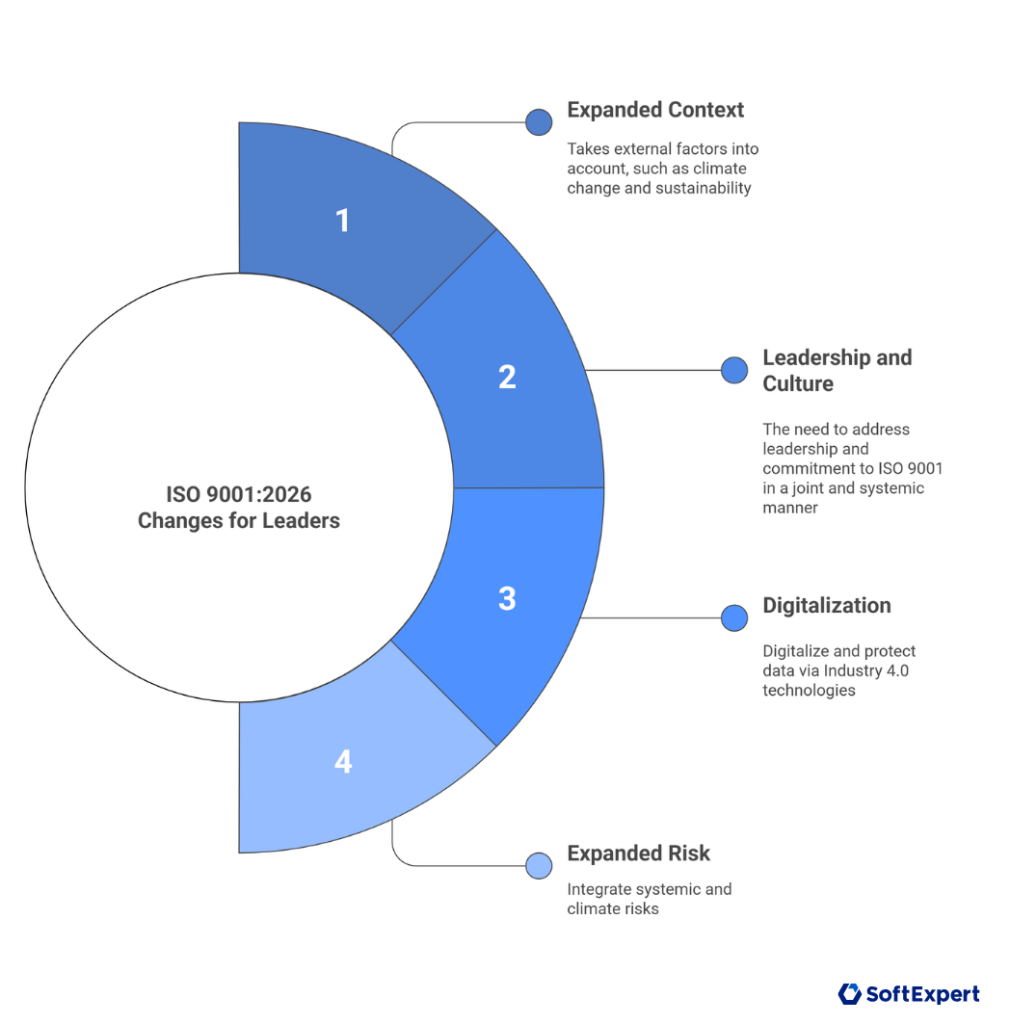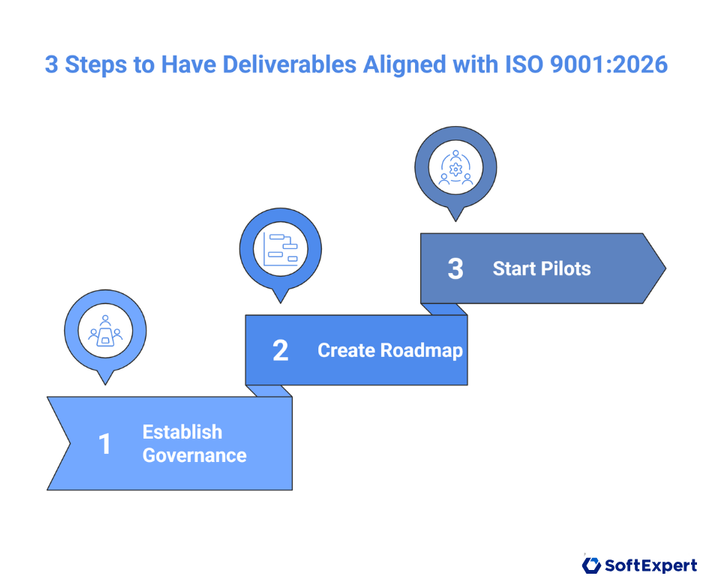The ISO 9001 revision took a crucial step with the release of the Draft International Standard (DIS) for voting; final publication is anticipated for 2026. The new version of ISO 9001:2026 highlights the broader organizational context (including climate change), reinforces leadership and culture, and makes digitization and data integrity central elements of Quality Management Software (QMS).
In this new context, Senior Management should promptly approve an executive diagnosis, form a multisectoral committee, and prioritize Industry 4.0 pilots who generate reliable digital evidence.
Therefore, the revision of ISO 9001 is not merely a technical update with operational implications. It realigns the standard with market demands and stakeholder expectations: transparency, resilience, and responsible use of technology.
For leaders, the question is not “if” but “how”: how to turn compliance into a competitive advantage by bringing together leadership and commitment to ISO 9001, climate risk, and data governance.
Organizations that anticipate these changes will reduce regulatory risk and increase their competitiveness – and you can find out how to do it in this article.

What does the ISO 9001:2026 update change for executive leaders?
The new ISO 9001:2026 maintains the structure based on Annex SL, but now brings emphasis that changes the role of leadership, especially in relation to digital transformation.
Some of the most significant changes are:

Expanded context
The ISO 9001 update makes it explicit that external factors, including climate change and sustainability, must be considered in a corporation’s organizational context. This requires executive leadership to define materiality criteria and strategic priorities, especially considering ESG practices.
Leadership and culture
Leadership 4.0 transitions from a mere policy signatory to a protagonist of results. In this new paradigm, transition auditors will be attentive to evidence of behavior, decisions, and resource allocation, not just documents.
In other words, treating leadership and commitment to ISO 9001 in a joint and systemic manner will be an essential practice. This means that leadership will be assessed not only by its words but by the coherence between discourse and action, and by the way its decisions and attitudes build a culture where quality is a shared responsibility at all organizational levels.
Digital data digitization and integrity
One of the changes generated by the 2026 version of ISO 9001 is the greater adoption of the technologies of the so-called Industry 4.0. Some of the main ones are Internet of Things (IoT), Data Analytics, Process Automation, and Artificial Intelligence (AI), as they transform the nature of compliance evidence.
Along with the use of these tools, the new standard requires attention to data governance, traceability, and the reliability of the digital evidence generated by them.
Increased risk
Risk-based thinking evolves to integrating systemic and climate risks, making convergence between QMS, ERM, and ESG agendas necessary. The goal of this update is not to create an extensive list of new operational controls, but rather to change what leadership requires and monitors: strategic decisions, digital evidence, and measurable results.
Industry 4.0 and ISO 9001: how to connect strategy, technology, and compliance
Industry 4.0 transforms quality management with AI technology, smart devices, digital twins, and predictive models. The great differential that demands the attention of leaders is that these tools generate continuous data that, when well governed, transforms timely evidence into a constant flow of proof of compliance.
As a result, the company’s operation becomes more efficient and modern. Thus, the products/services comply with the main standards, and the company’s positive reputation is reinforced both for customers and for other stakeholders.
To structure this process properly, top management must therefore decide on:
- who is responsible for the integrity of the data that feeds quality decisions;
- what AI algorithms and models can be used, and how to validate and audit these models;
- which KPIs in real time will be presented to executive leadership, and how to relate them to the business value they represent (such as cost, time to value, risk mitigation, reputation protection, among others).
Organizations that treat the combination of leadership and commitment in ISO 9001 as an integral part of QMS gain predictability, reduce rework, and demonstrate operational robustness for customers and certifiers.

How to unite leadership and commitment in practice?
For leadership to truly demonstrate commitment, it takes more than words. Management in the new ISO 9001:2026 is based on commitment, which, in turn, requires proof, such as approved decisions, allocated resources, visible communication, and monitoring of results.
To turn intention into evidence, top management must:
- formally approve the roadmap of actions, changes, and adaptations generated by the changes to ISO 9001:2026 and monitor the milestones of all this;
- integrate QMS with ERM, the ESG agenda, and the company’s strategic objectives;
- define the success criteria for investments (whether in time, money, personnel, or training) in digitalization;
- ensure communication efforts and the development of a digital innovation culture are both measurable and scalable.
This type of care not only helps optimize operations but also facilitates the adoption of Industry 4.0 technologies and methodologies. Just as important, having hands-on leadership facilitates internal and external compliance audits – and increases your chances of success.
Remember: certification auditors will look for concrete actions (board approvals, revised KPIs, and evidence such as logs and reports) that prove the effective implementation of the new ISO 9001:2026.
3 steps to have deliverables aligned with ISO 9001:2026
To learn how to achieve this balance between strategy, digital transformation, and compliance that is demanded by the updated ISO 9001 in 2026, you can follow the roadmap below. It was designed to guide executive leadership decisions, indicating the objectives and deliverables of each stage.

1. Organize governance and make an executive diagnosis
The first step is to approve the Board’s mandate for the QMS review, considering the changes in ISO 9001. To do this, conduct a gap analysis of your operations against the requirements outlined in the Draft International Standard (DIS) and the Final Draft International Standard (FDIS) of the standard. Seek to identify critical processes, data sources, and strategic suppliers that will assist in the adaptation process in the future.
The main delivery of this stage is precisely this executive gap analysis report, which will dictate the necessary actions and investments later.
2. Create the roadmap and allocate resources
After understanding the current stage of your operation and identifying what needs to be adjusted, it’s time to create the roadmap with priority actions (e.g., data integrity, telemetry pilot, leadership training).
Then, define the budget for each initiative and the strategic objectives and results in indicators for each one. A good practice that helps make this organization easier, more transparent, and more effective is to establish a transition committee with representatives from areas such as Quality, IT, Sustainability, and Compliance.
The great delivery of this committee will be the roadmap approved and with a defined financing plan.
3. Start pilots and strengthen communication
Then it’s time to get your hands dirty. Once the planning stage is over, implement pilot projects that generate validated digital evidence of compliance.
Based on the performance of these pilots, make any necessary adjustments to the company’s policies and procedures. At the same time, launch a communication program to align discourse with practice and build an executive dashboard that makes relevant information available to those involved in the project, which increases the transparency and engagement of the project.
The essential deliverables of this phase of the project are the pilots with quantified results, revised policies, and a monitoring dashboard. In addition, build monthly reports that show evidence (logs, hashes, validations) and impacts on relevant indicators, such as financial or risk.
Risks of not acting and opportunities to adapt early
Ignoring the ISO 9001:2026 update poses exposure to regulatory risks, business losses, and excessive remediation costs. In regulated sectors, not anticipating requirements on sustainability and data can affect sales and contracts with suppliers, and even lead to fines and legal sanctions by regulatory entities.
On the other hand, organizations that begin the integration between Leadership 4.0 and the new standard gain operational efficiency, improve quality predictability, and turn compliance into a business argument. Preparing the company in advance tends to reduce migration costs and avoid reactive fixes at scale.
Understand more about the impacts, both negative and positive, that the change in ISO 9001 can generate in the management of your company:
- Risks: The main ones are exposure to failures in certification processes, loss of contracts that require updated compliance, higher remediation costs, and reputational impact that affects sales.
- Opportunities: Opportunities present themselves in operational efficiency with continuous monitoring, commercial argumentation based on digital evidence of compliance, greater ease of access to markets, and sources of financing that value transparency and digital compliance.
Quality Week: A chance to prepare for the future
The World Quality Week is a unique annual opportunity to anticipate and cultivate the mindsets that the new standards will demand.
The ISO 9001:2026, for example, challenges us to integrate climate change, foster a culture of ethical quality, and adopt clearer management of risks and opportunities. These guidelines are an invitation to profoundly rethink the role of quality in organizations.
The Quality Week serves as a perfect laboratory to initiate important transitions. Over the years, its pillars of action have shown themselves to be directly connected to the emerging requirements of the standards, such as those of ISO 9001:2026:
- Alignment: It is the ideal time to reflect and initiate adjustments, ensuring that quality is the core of your business strategy, and not an appendix.
- Performance: Participating in the Week is an opportunity to strengthen the culture of data analysis and performance, which is the basis for meeting the new requirements of the new standard.
- People: Quality Week traditionally reinforces that “quality is everyone’s responsibility.” Engaging the team in the event’s activities helps prepare the ground for the new training and awareness requirements of clause 7.3.
Conclusion
The ISO 9001 update is a strategic opportunity. Leadership 4.0 should act as an enabler of QMS that integrates climate risk into its processes and that requires digital evidence of compliance. Thus, it is possible to transform compliance into a competitive advantage through digitalization and ESG practices.
Acting with priority and strategic clarity over the next 12 months will reduce risk and position your organization to compete in a market that values transparency, resilience, and proven quality.
Looking for more efficiency and compliance in your operations? Our experts can help identify the best strategies for your company with SoftExpert solutions. Contact us today!
FAQ about leadership and commitment in the ISO 9001:2026
ISO 9001 is in the Draft International Standard (DIS) phase and final publication is scheduled for 2026. The transition typically takes three years for full implementation. Organizations should consider the preparation window now to avoid reactive adjustments and remediation costs.
The standard reinforces that leadership should: consider a broader organizational context (including climate change), demonstrate commitment through decisions and resource allocation, and integrate digitization and data governance into the QMS framework.
Priority actions involve approving an executive diagnosis (gap analysis aligned with DIS/FDIS), instituting a multisectoral committee, and prioritizing pilots that generate reliable digital evidence. These steps generate concrete deliverables for auditing and governance.
Percentage of compliance in critical processes; average time to correct high-impact non-conformities; automated records integrity rate; reduction of rework linked to digital initiatives; exposure to materialized climate risks.
No, ISO 9001:2026 will not become an environmental management standard and will not require emissions reporting. However, it will require the organization to determine if climate change is a relevant risk to its QMS and, if so, to treat these risks as it would any other.





